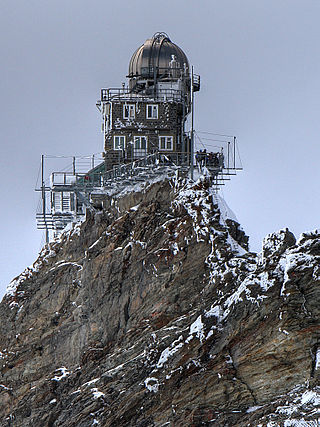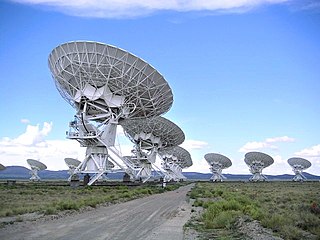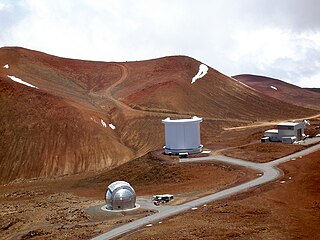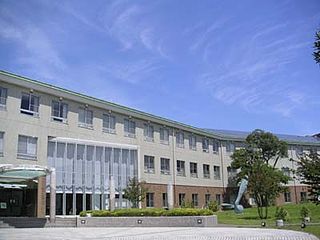
An observatory is a location used for observing terrestrial, marine, or celestial events. Astronomy, climatology/meteorology, geophysics, oceanography and volcanology are examples of disciplines for which observatories have been constructed.

Subaru Telescope is the 8.2-metre (320 in) telescope of the National Astronomical Observatory of Japan, located at the Mauna Kea Observatory on Hawaii. It is named after the open star cluster known in English as the Pleiades. It had the largest monolithic primary mirror in the world from its commissioning until the Large Binocular Telescope opened in 2005.

The National Radio Astronomy Observatory (NRAO) is a federally funded research and development center of the United States National Science Foundation operated under cooperative agreement by Associated Universities, Inc. for the purpose of radio astronomy. NRAO designs, builds, and operates its own high-sensitivity radio telescopes for use by scientists around the world.

The Atacama Large Millimeter/submillimeter Array (ALMA) is an astronomical interferometer of 66 radio telescopes in the Atacama Desert of northern Chile, which observe electromagnetic radiation at millimeter and submillimeter wavelengths. The array has been constructed on the 5,000 m (16,000 ft) elevation Chajnantor plateau – near the Llano de Chajnantor Observatory and the Atacama Pathfinder Experiment. This location was chosen for its high elevation and low humidity, factors which are crucial to reduce noise and decrease signal attenuation due to Earth's atmosphere. ALMA provides insight on star birth during the early Stelliferous era and detailed imaging of local star and planet formation.

La Silla Observatory is an astronomical observatory in Chile with three telescopes built and operated by the European Southern Observatory (ESO). Several other telescopes are also located at the site and are partly maintained by ESO. The observatory is one of the largest in the Southern Hemisphere and was the first in Chile to be used by ESO.

The James Clerk Maxwell Telescope (JCMT) is a submillimetre-wavelength radio telescope at Mauna Kea Observatory in Hawaii, US. The telescope is near the summit of Mauna Kea at 13,425 feet (4,092 m). Its primary mirror is 15 metres across: it is the largest single-dish telescope that operates in submillimetre wavelengths of the electromagnetic spectrum. Scientists use it to study the Solar System, interstellar dust and gas, and distant galaxies.

Llano de Chajnantor Observatory is the name for a group of astronomical observatories located at an altitude of over 4,800 m (15,700 ft) in the Atacama Desert of northern Chile. The site is in the Antofagasta Region approximately 50 kilometres (31 mi) east of the town of San Pedro de Atacama. The exceptionally arid climate of the area is inhospitable to humans, but creates an excellent location for millimeter, submillimeter, and mid-infrared astronomy. This is because water vapour absorbs and attenuates submillimetre radiation. Llano de Chajnantor is home to the largest and most expensive astronomical telescope project in the world, the Atacama Large Millimeter Array (ALMA). Llano de Chajnantor and the surrounding area has been designated as the Chajnantor Science Reserve by the government of Chile.

Associated Universities, Inc. (AUI) is a research management corporation that builds and operates facilities for the research community. It is a not-for-profit 501(c)(3) corporation headquartered in Washington, D.C., United States. The current president is Adam Cohen. The corporation's major current operating unit is the National Radio Astronomy Observatory, which it operates under a Cooperative Agreement with the National Science Foundation.

An extremely large telescope (ELT) is an astronomical observatory featuring an optical telescope with an aperture for its primary mirror from 20 metres up to 100 metres across, when discussing reflecting telescopes of optical wavelengths including ultraviolet (UV), visible, and near infrared wavelengths. Among many planned capabilities, extremely large telescopes are planned to increase the chance of finding Earth-like planets around other stars. Telescopes for radio wavelengths can be much bigger physically, such as the 300 metres aperture fixed focus radio telescope of the Arecibo Observatory. Freely steerable radio telescopes with diameters up to 100 metres have been in operation since the 1970s.

The Nobeyama Radio Observatory (NRO) is a division of the National Astronomical Observatory of Japan (NAOJ) and consists of three radio instruments located near Minamimaki, Nagano at an elevation of 1350m.

TAMA 300 is a gravitational wave detector located at the Mitaka campus of the National Astronomical Observatory of Japan. It is a project of the gravitational wave studies group at the Institute for Cosmic Ray Research (ICRR) of the University of Tokyo. The ICRR was established in 1976 for cosmic ray studies, and is currently developing the Kamioka Gravitational Wave Detector (KAGRA).

The Institute for Cosmic Ray Research (ICRR) of the University of Tokyo was established in 1976 for the study of cosmic rays.

The Graduate University for Advanced Studies, SOKENDAI is one of the national universities of Japan, headquartered in Shonan Village (湘南国際村) in the town of Hayama in Kanagawa Prefecture. Sōkendai (総研大), as it is generally called in its abbreviated form, was established in 1988, with Dr. Saburo Nagakura as its president. SOKENDAI is the first national university in Japan having offered exclusively graduate programs. Graduate students are trained at affiliated research institutes distributed around Japan and the world. It has both five-year doctoral programs for students with a bachelor's degree and three-year programs for those with a master's degree.
The Tokyo Photoelectric Meridian Circle (PMC) is a meridian circle that observes and records the positions of stars and planets, which are then reported in the PMC catalogs.

The Nano-Japan Astrometry Satellite Mission for Infrared Exploration (Nano-JASMINE) is an astrometric microsatellite developed by the National Astronomical Observatory of Japan, with contributions by the University of Tokyo's Intelligent Space Systems Laboratory (ISSL). As of 2015, the satellite was planned for launch together with CHEOPS in 2019. However, this launch took place in December 2019 without Nano-JASMINE as one of the three piggyback payloads. Some sources named 2022 as the launch year of the satellite. By 2023, the launch had been cancelled and the satellite is now displayed in Kakamigahara Air and Space Museum.

Cerro Murphy Observatory is an international astrophysical project hosted by the ESO Paranal Observatory and operated by the Nicolaus Copernicus Astronomical Center of the Polish Academy of Sciences. The observatory is located on Cerro Murphy, which is a hill located 1 kilometre to the southwest and 230 metres (750 ft) below the summit of Cerro Armazones, a mountain in the Antofagasta Region of Chile, 120 km (75 mi) south of Antofagasta. OCM is located at 2,817 m (9,242 ft) altitude and currently houses 5 telescopes, whose diameters range between 0.3 and 1.5 m.

Norio Kaifu was a Japanese astronomer. He was best known as the president of the International Astronomical Union (IAU) from 2012 to 2015. He directed the Subaru telescope project, which housed the largest monolithic primary mirror in the world from its commission until 2005. Kaifu researched in radio astronomy, extragalactic astronomy, cosmic magnetic fields, non-stable stars, and infrared astronomy. The minor planet 6412 Kaifu is named in his honor.



















